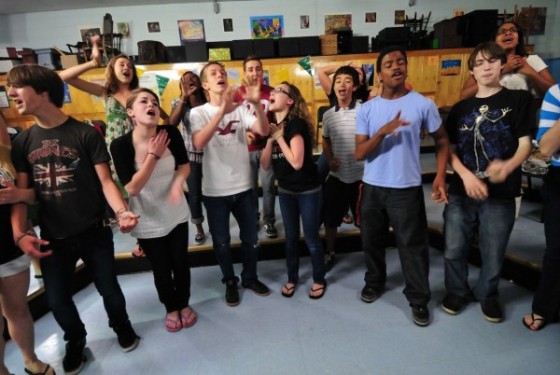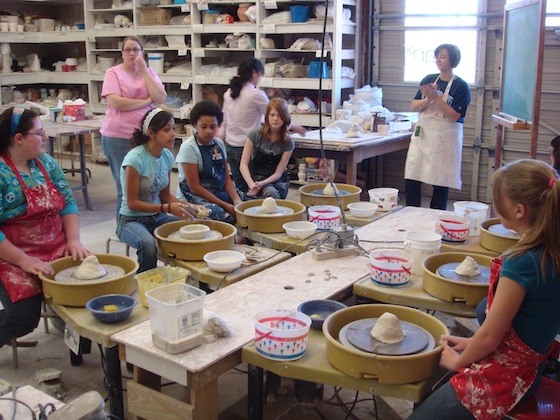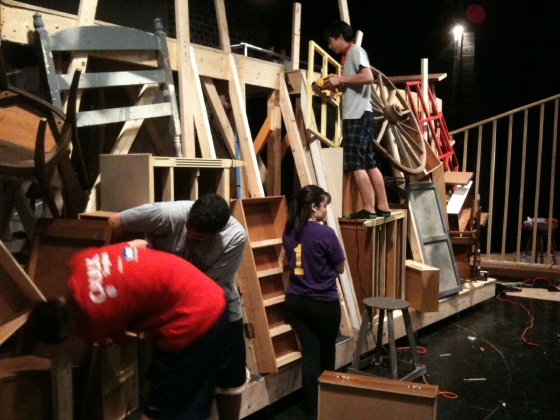For a long time I’ve watched my husband Steve, a drama teacher, work his magic in his classes and dramatic productions. Lately, I’ve been reading posts from core subject teachers (e.g., science, math, history) who are beginning to move from the transmissive pedagogy more likely to be found in traditional subjects and wanting to explore a more student-centered, inquiry, or project-based approach.
This growing urge among teachers to put students center-stage has made me revisit some thoughts about the wealth of knowledge the arts teachers in our buildings have about this topic. The trouble is that they don’t often speak up. They quietly go about their work, often marginalized to the ‘extras’ or the ‘fluff’ of the school program — and yet, I would argue that they are the PBL experts that we seek!
Check out this quote from David Booth’s book called Story Drama. Doesn’t this sound a lot like the project-based classroom many of us yearn to create?
This is the drama teacher’s struggle: listening, watching, setting up situations that will foreshadow the direction of the journey, knowing when to intervene, when to use a particular strategy to open up discussion, to move the students into action, to cause them to pause, to reflect, to rethink, and all this without predetermining the learning, the content, the meat of the lesson.
What hit me is that this quote really typifies the kind of work we all ought to be doing in our classrooms. The delicate dance of teaching involves watching, inspiring, coaching, providing choices, respecting, motivating and providing rich content experiences…such a complex task indeed!
So what are the fundamentals that we might we borrow from the arts teachers to support student-directed learning in other domains?
Arts teachers know that knowledge is a private reflection until we give it social value
This is really the key to much of our discussion about 21st century learning these days. New tools afford us the opportunity to articulate our understanding in new ways and make it far more accessible — no longer just text-based, and no longer created for just one teacher, or just one class. Audiences have moved from the single classroom to the global community.
In much the same way that students are motivated by the performances in arts education, student engagement goes up when students are creating artifacts to share with their community, either virtually or face to face — or they correspond with people who have experiences to share that relate to their own studies — or they bring their questions and new understandings to experts (e.g., scientists, authors, or other classes) via online conversations.
Arts teachers know how to build communities where all voices are valued and taking risks is safe
This might be one of the most difficult parts of transforming the classroom from a teacher-directed space to a student-focused space. Arts teachers have expertise in this area.
New skills such as accountable talk, self-regulation, and the ability to build and maintain a comfortable, equitable and safe space for communicating need to be acquired by both teachers and students. How does that happen in an arts classroom? Team-building, trust-building, conflict resolution and teacher modeling of effective feedback helps that emerge over time. Routines are established that teach students how to cooperate; how to lead sometimes, and how to be led by peers other times.
In the arts classroom, effective teachers also participate as co-learners; sometimes leading, sometimes letting students take the lead, always modeling the kinds of interactions they are hoping to see within the learning community. It’s crucial that they sometimes play the role of ‘student’ in order to do this modeling of what learning looks like.
Not only do arts educators create supportive social environments, they promote risk-taking by stressing the real work of the arts. Students BECOME actors, painters, dancers and musicians and they explore with the teacher who invites them into this ‘tribe’ through modeling the ways of BEING and DOING in their particular domain.
Shouldn’t this happen in other subject areas? As Seymour Papert puts it: “(B)eing a mathematician, again like being a poet or a composer or an engineer, means doing rather then knowing or understanding.” Authentic projects can bring students into “being and doing” as they personally connect to curriculum. We don’t have to be arts educators to employ this potent learning strategy.
Arts teachers are skilled at differentiation
Differentiation is the name of the game in the arts classroom. Most often the courses are open, bringing together students with a variety of backgrounds and abilities. Individuals are valued for their unique strengths that make team work more effective. Through the use of technology, teachers in other subject areas are beginning to see how students can blend images, sound, music, and text to create powerful messages and artifacts that allow all students to be successful.
Teachers of the arts know this secret: feedback that is immediate, descriptive and supportive of the whole group changes the role of assessment — and students often share in this process through peer and self-assessment.
Arts teachers approach learning as a balance of process & product with a focus on reflection
Arts educators believe that process, structures and techniques are important to their craft, and that since the arts are meant to be shared, a product is equally important. This understanding of balance keeps the focus on acquiring and improving skills while also creating public artifacts that demonstrate this learning.
The work of the arts is never quite finished, and reflection is a constant part of the process. Imagine rich portfolios of students’ work as scientists, historians or mathematicians, expanding and demonstrating increasing mastery throughout their years at school.
So how do you get help from teachers of the arts?
One thing is a given – inquiry-based approaches involve following students along paths that you might not be able to predict – and that involves responsive teaching. I’d recommend that you go and search out your arts teachers. They are usually really passionate about their subject area, just as you are, and may be eager to share their expertise.
For starters you might ask some of these questions to get a conversation going (and glean an invitation to observe):
- What techniques are used to build an effective community of learners?
- What strategies and structures are put in place to manage a classroom that focuses on discussion, sharing and reflection?
- How do teachers handle the fact that the endpoint isn’t always what is planned or expected?
You may also be interested in this collection of lesson plans, websites and PD resources for Arts Integration recently gathered by Edutopia.
Images (from top): NEA Today, Creative Commons, Ed Allen
Brenda Sherry
Latest posts by Brenda Sherry (see all)
- PBL Experts Are All Around Us! - February 8, 2013
- Diving Deeply: Networks or Communities? - April 13, 2012





I have always said that teachers of the arts should run the school. They have the collective, integrated schema to see things in big picture strokes and not in isolated disciplines.
Great post.
Thanks for this, Sheryl.
That’s a great point about arts educators running the school – I’ve never taught at an arts school but I wonder if that is what contributes to their success?
Brenda
Hello from New Zealand! I have just stumbled on this website… Thank you for your post – I am passionate about PBL (both project & problem). Your post is inspiring and an excellent reminder about creating safe learning communities where our children are allowed to “think”. Arts in the classroom is indeed a wonderful way to promote PBL. Your post offers an opportunity to professionally reflect on ways PBL can be made a priority in our children’s learning. I will be sharing this with my colleagues thank you.
Hi Fiona,
Thanks for sharing this post with teachers in New Zealand! I’d love to hear how you and your colleagues are making more integrated approaches work in your setting. I assume that you would have some of the same issues around separate curriculum areas and timetabling — are you finding that PBL is more prevalent in some areas/grades/subjects than in others?
Brenda
Hi Brenda,
We tend to talk about inquiry learning rather than PBL. Six years ago I was introduced to the SOLO Taxonomy. After exploring different ways to best use this taxonomy, I found that it all starts at the planning stage. I created a basic integrated planning format and block in each stage of the SOLO taxonomy over the term. Then I use the school learning overviews for required learning areas and make links where possible. For example a reading programme at the start of the term will be developing research skills to collect information. Using this integrated format allows me to work with time constraints and curriculum requirements, it also challenges me to plan backwards! This means there is deliberate time allocation and planning around problem based learning which in my experience tend to occur at the “relational” and “extended abstract” stages of the SOLO taxonomy. The integrated plan creates a skeleton of the teaching and learning journey but nothing is set in concrete. By planning like this my children don’t spend all their learning time on research or questioning – we move into cause and effect then creating… This of course depends on the students’ learning journeys. Interestingly, colleagues have admitted that integrated planning is a challenge because they still think of learning as linear and individual. Needless to say – Your post was perfect timing indeed!
Wow Fiona! I’m always in awe of how social media connects us across the world and brings us to new learning…thanks so much for taking time to go into more explanation of the construct you use for your planning. I don’t know SOLO and have checked it out online here – it will be definitely something I want to explore. Is that a good place to start?
http://www.learningandteaching.info/learning/solo.htm
I share your interest in backward design within a flexible format and I like the use of the word ‘skeleton’ to describe your plan. Having my plan laid out makes me feel confident I’m focusing on curriculum to the extent that I should, and it makes me more comfortable about the ‘big picture’ – therefore more comfortable with being more flexible about where the students’ interest needs to take us!
Brenda
I agree – I have really enjoyed reading the posts on this website. Another post discussed turning the Blooms Taxonomy upside down – I might play with this idea with SOLO and start from extended abstract. I am beginning to see how it might promote more PBL especially in science!
The website you suggested looks good – you could google “SOLO hooked on thinking” and the following websites may also be useful:
pamhook.com/solo-taxonomy/
pamhook.com/…/SOLO_Taxonomy_and…
Thanks for your feedback regarding planning – I agree it does give me more confidence to be flexible with children’s interest in learning.
Have a great week.
What you say is true, only an art teacher has the talent to convert the classroom from a teacher-directed approach to student focused space. It is understandable that students are more refined and independent in arts class than in subject classes.
We need to hear more of their secrets, don’t we? I’m thinking of a follow interview-style post to extract some of their nuggets of wisdom….stay tuned!
Brenda
Brenda – loved the post. The part that saddened me is that, at least at the elementary level, we have gotten rid of our arts specialists, and many generalist teachers don’t necessarily have that background in creating the “reflective space” we’re looking for. I love the freedom my “band-ies” feel when they’re in their zone, in the music room, sharing and creating, and working, individually and collectively, to create something magic. My role there is often to get out of the way, once they’re on a roll in small groups. But….many of our elementary students can go from K-8, without encountering that kind of space. How do we get that expertise out there?
Well…I’m thinking that an interview post might be a good start. It would be nice to hear about both specific strategies and an overall ‘feeling’ that you strive for in that ‘reflective space’ you mention.
Would you be willing to respond to a few questions?
Brenda
This is a really good article. While I include “transdisciplinary” approaches whenever possible with visual art content, I notice that the visual arts are further removed from dedicated art time compared to general music, health, and now currently, Mandarin and Spanish. Technology is also so far forward that we have to remind ourselves of the advantage in collaboration, styles of learning, and in “made by hand”(process), areas to understand logical choices.
Thank you.
Thanks for your comment, Nancy.
You bring up a really good point about the advantage that technology affords us in sharing our processes. So much about what teachers of the arts do might be articulated on blogs with examples – this would help so many other teachers! I love the idea of archiving visual arts products online too – so much goes into creating galleries at school, now those examples can live on and reach a wider audience!
Brenda